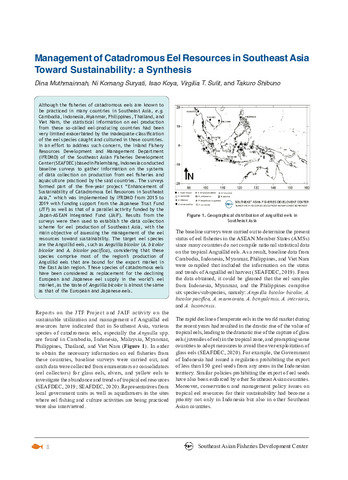| dc.description.abstract | Although the fisheries of catadromous eels are known to be practiced in many countries in Southeast Asia, e.g. Cambodia, Indonesia, Myanmar, Philippines, Thailand, and Viet Nam, the statistical information on eel production from these so-called eel-producing countries had been very limited exacerbated by the inadequate classification of the eel species caught and cultured in these countries. In an effort to address such concern, the Inland Fishery Resources Development and Management Department (IFRDMD) of the Southeast Asian Fisheries Development Center (SEAFDEC) based in Palembang, Indonesia conducted baseline surveys to gather information on the systems of data collection on production from eel fisheries and aquaculture practiced by the said countries. The surveys formed part of the five-year project “Enhancement of Sustainability of Catadromous Eel Resources in Southeast Asia,” which was implemented by IFRDMD from 2015 to 2019 with funding support from the Japanese Trust Fund (JTF) as well as that of a parallel activity funded by the Japan-ASEAN Integrated Fund (JAIF). Results from the surveys were then used to establish the data collection scheme for eel production of Southeast Asia, with the main objective of assessing the management of the eel resources toward sustainability. The target eel species are the Anguillid eels, such as Anguilla bicolor (A. bicolor bicolor and A. bicolor pacifica), considering that these species comprise most of the region’s production of Anguillid eels that are bound for the export market in the East Asian region. These species of catadromous eels have been considered as replacement for the declining European and Japanese eel supply in the world’s eel market, as the taste of Anguilla bicolor is almost the same as that of the European and Japanese eels. | en |

